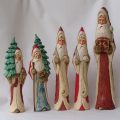The Spring 2011 issue (available in February) of Woodcarving Illustrated features an article demonstrating how to carve a diving otter in found wood by Sumner Misenheimer.
Sumner’s father introduced him to woodcarving when Sumner was a young boy, and his father encouraged Sumner’s art talents through his school years.
After Sumner earned journeyman status as a silversmith and silver chaser, he moved into management. After 18 years in industry, Sumner opened his own printing business, Minuteman Press of Newburyport, Mass., and decided to get back into carving to relax and relieve stress. Now Sumner carves in his shop nearly every night. He sells his work to collectors and accepts commissions.
To see more of Sumner’s work, visit his website at www.wildlifeartisan.net.
Carving in Found Wood
Sumner has several rules when it comes to carving a stylized or interpretive piece in found wood.
- Make it interesting to look at.
- Make it tell a story–an otter is great, but an otter chasing a fish is better and more interesting
- Do a good job–sanding and finishing can be the best feature of a whole job
- Make something you like–otherwise it is only firewood. If you like the carving, it is a sucess.
- Complete the carving even if you don’t like it. Let it evolve into something you do like. Perhaps the otter winds up being a mouse sitting on a maple leaf. Refer back to Rule #4.
That doesn’t mean that every carving comes easily for Sumner. “Sometimes I hit an artist’s block when nothing feels right about my carving,” Sumner explained. “When this happens, it time to put this carving away for a while and work on something else. Almost always, the next time I pick up that carving, I am back on track.”
Carving in found wood has it’s own rewards and challenges.
“I love the wood looks,” Sumner said. “Its feel, grain, and color are strong factors in my final carving. If I am carving found wood, there will be numerous times when the nature of the wood will greatly influence the final piece. The challenge here is to follow the grain with every component of the carving and deal with the natural faults in the wood to integrate them into the carving.
“Many carvers are so interested in matching an exact pattern or drawing they are unable to be free with their work and just have fun with it,” Sumner continued. “We all started out carving by whittling a stick or a bar of soap. I am still doing that, just with a litter bigger stick, but my imagination still leads my knife.”
Sumner tries to keep one part of the figure or animal as accurate as possible when doing an interpretive carving. “This can take a little research into anatomy,” Sumner said. “The internet is loaded with reference material.”
For a complete how-to article on how to carve a diving otter complete with reference photos and patterns, see Woodcarving Illustrated Spring 2011 (Issue 54 – available in February).
Don’t miss an issue of Woodcarving Illustrated – Subscribe Today!






